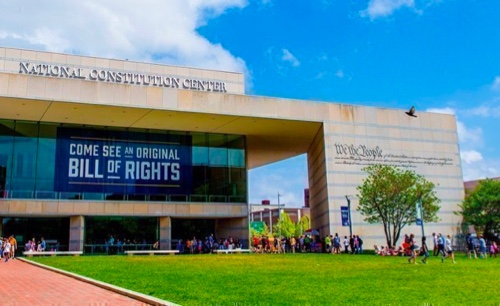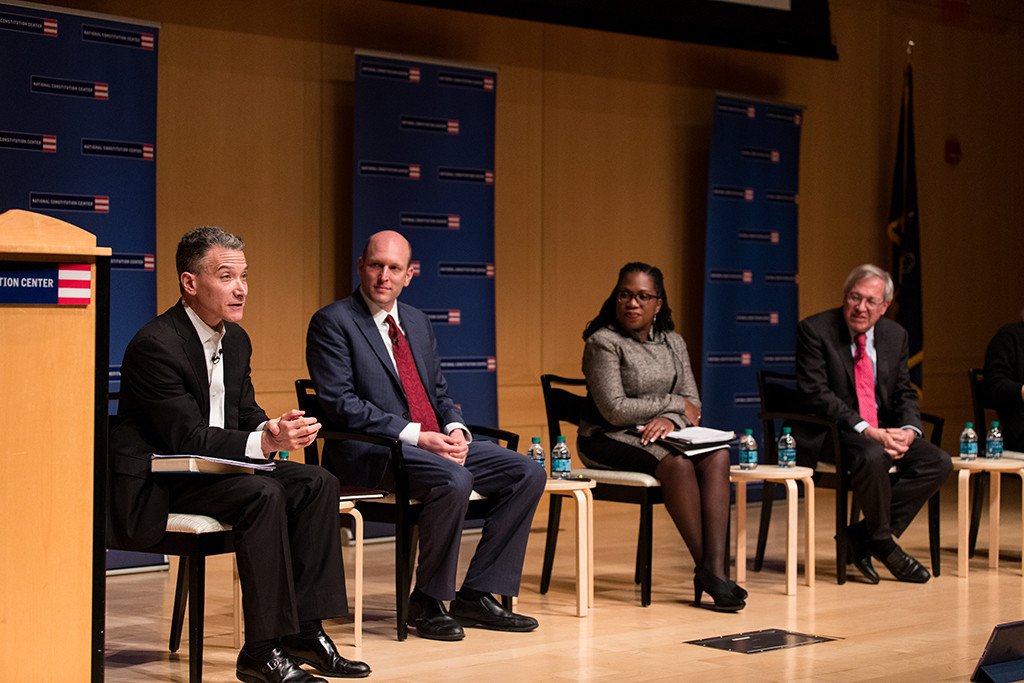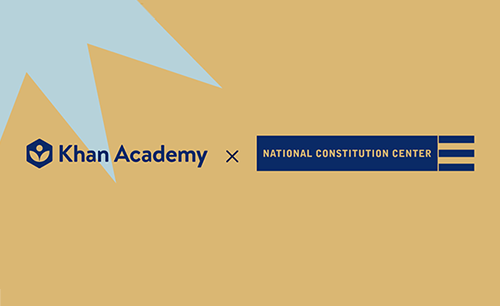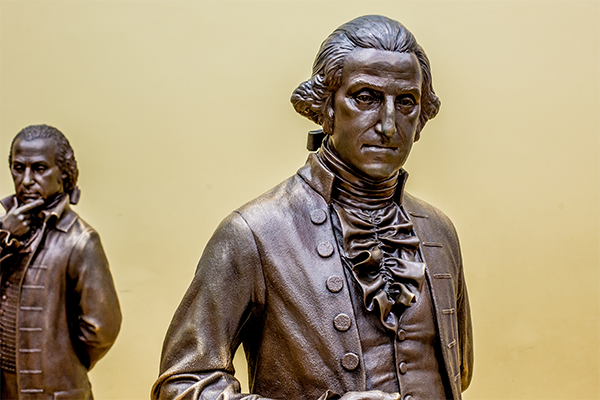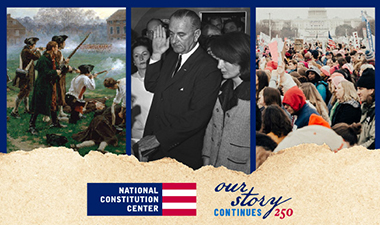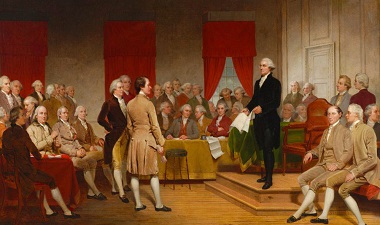At the National Constitution Center, we value civil dialogue, which empowers students to speak about constitutional and historical topics in ways that remain civil, respectful, and reflective. As you prepare to discuss these topics in your classroom, we encourage you to establish norms such as:
- Stay calm
- Listen patiently
- Listen actively
- Don’t speak twice until everybody has spoken once
You can find more support for establishing norms and civil dialogue practices in our Civil Dialogue Toolkit.
Media Asset
Constitution Daily Blog Post: What the Constitution Says About Free Speech on the Airwaves, by Scott Bomboy, editor in chief at the National Constitution Center
Big Constitutional Questions
What does the Constitution say about free speech on the airwaves?
Headline Story
Late-night host Jimmy Kimmel was suspended from his ABC program after remarks he made about a high-profile news story. Following his comments, some local affiliates decided not to air his show, and ABC’s parent company, Disney, announced an indefinite suspension. Around the same time, Federal Communications Commission (FCC) Commissioner Brendan Carr suggested the FCC might examine whether ABC and its affiliates met their public-interest obligations.
The situation raised different reactions. Some observers questioned whether government commentary about broadcast content could discourage speech in ways that implicate the First Amendment. Others emphasized that broadcast networks, as FCC license holders, have unique responsibilities to serve the public interest and may choose how to handle programming.
This ongoing debate illustrates a larger constitutional issue: how to distinguish between private business decisions, regulatory oversight, and government pressure that could cross into unconstitutional restrictions on speech.
Amendment / Clause Focus
- First Amendment
- Free Speech, Free Speech Clause
- Supreme Court Precedent: Free speech protections apply to all levels of government (Stone & Volokh, NCC Interactive Constitution).
- Protected vs. Unprotected Speech:
- Protected: even “hate speech” (see Matal v. Tam (2017), Alito: “the proudest boast of our free speech jurisprudence is that we protect the freedom to express ‘the thought that we hate.’”)
- Unprotected: defamation, “true threats,” fighting words, obscenity.
|
Scholar |
Key Ideas & Quote |
Why It Matters |
|
Geoffrey R. Stone (Univ. of Chicago) |
“So-called ‘hate speech’– speech that expressly denigrates individuals on the basis of such characteristics as race, religion, gender, national origin, and sexual orientation – does not constitute low value speech because it has not historically been subject to regulation. As a result, except in truly extraordinary circumstances, such expression cannot be regulated consistent with the First Amendment” |
Even if speech is offensive or unpopular, the First Amendment usually protects it. That means comments like Kimmel’s still fall under constitutional protection, even if some people find them harmful. |
|
Eugene Volokh (UCLA) |
“I think speech about elections, including speech that costs money, must remain protected, whether it’s published by individuals, nonprofit corporations, labor unions, media corporations, or nonmedia business corporations.” “But here the government is pressuring all employers, universities, and businesses to impose speech codes, by threatening liability on those who don’t impose such codes. And that government pressure is subject to First Amendment scrutiny.” |
It stresses that broad categories of political expression, even when controversial or expensive, are constitutionally protected. Highlights the difficulty of drawing lines without risking overreach. Just as FCC pressure may raise free speech concerns, government-backed speech codes or liability rules can blur the line between private enforcement and state censorship. |
Primary Source Spotlight (Embedded Excerpts)
First Amendment (1791): "Congress shall make no law...abridging the freedom of speech, or of the press..."
FCC Policy (1934 Act, § 326): “no regulation or condition shall be promulgated or fixed by the [Commission] which shall interfere with the right of free speech by means of [over-the-air] broadcast communication.”
National Rifle Association of America v. Vullo (2024): “Government officials cannot attempt to coerce private parties in order to punish or suppress views that the government disfavors.”
Think, Talk, Create
Download Think, Talk, Create PDF
Student Questions
- What is the First Amendment to the Constitution? What protections does it grant Americans, specifically when it comes to free speech?
- In the Constitution Daily blog post, editor Scott Bomboy explains the parameters of free speech. Explain what those parameters are, and why he also mentions that “free speech rights are not absolute.”
- In your own words, explain what the Federal Communications Commission is, and identify the FCC’s powers regarding regulation of free speech according to the policies outlined in the blog post.
Student Choice Options
- Create a poster that highlights what free speech means to you. This can be digital or print.
- There are many Supreme Court Cases that deal with free speech and the First Amendment. Select a case from the National Constitution Center’s Supreme Court Cases Library, read the opinions of the case, and annotate the opinions using our Annotation guide [PDF]. Then answer the following questions:
- What were the facts of the case and how do they relate to free speech and the First Amendment?
- What did the opinions reveal about the ruling of the case? (Some cases may have majority, dissenting, and/or concurring opinions—select at least one of each when possible)
- To what extent do you agree with the outcome of the case? Support your response with evidence from the opinions of the case and other First Amendment resources.
- In their common interpretation of the Free Speech Clause of the First Amendment, Stone and Volokh outline the types of speech that can be restricted by the government, as well as types of speech that typically cannot be restricted by the government. Read this common interpretation and complete the Consensogram protocol to assess to what extent you agree or disagree with ABC’s suspension of Jimmy Kimmel using evidence from the First Amendment (blog post and common interpretation essay) to support your response.
Beyond the Headlines
- We The People Podcast: Can Government Officials Pressure Private Companies and Universities to Restrict Speech?
- National Constitution Center’s First Amendment Gallery: Exhibit exploration and Interactives
- Constitution 101
- Module 10, First Amendment (High School)
- Module 10, First Amendment (Middle School)
- Interactive Constitution
- First Amendment
- Freedom of Speech and the Press, scholar essays
